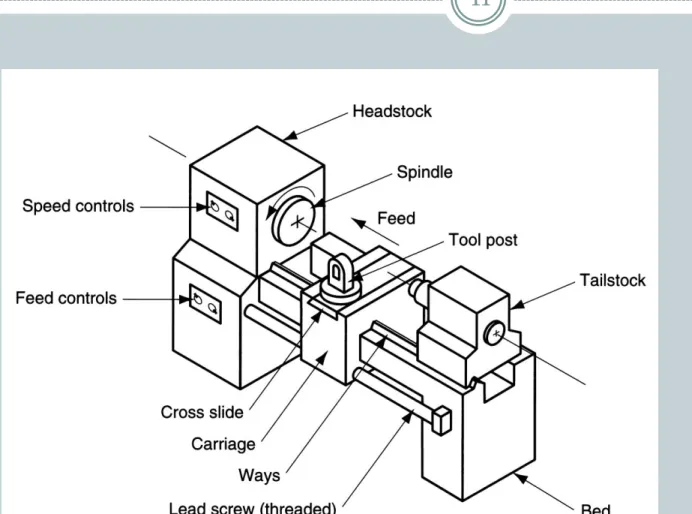MACHINING OPERATIONS AND MACHINE TOOLS
Turning
Drilling
Milling
Other Machining Operations
1
Machining
A material removal process in which a sharp cutting tool is used to mechanically cut away material so that the desired part geometry remains
Most common application: to shape metal parts
Machining is the most versatile and accurate of all manufacturing processes in its capability to produce a diversity of part geometries and geometric features
2
(a) straight turning, (b) taper turning, (c) contour turning, (d) plain milling, (e) profile milling
3
Forming to create shape: (a) form turning, (b) drilling, and (c) broaching
4
(a) thread cutting on a lathe, and (b) slot milling.
5
Turning
A single point cutting tool removes material from a rotating workpiece to generate a cylindrical shape
Performed on a machine tool called a lathe
Variations of turning that are performed on a lathe:
Facing
Contour turning
Chamfering
Cutoff
Threading
6
Turning operation
7
Facing.
Tool is fed radially
inwards.
8
Chamfering
Cutting edge cuts an angle on the corner of the cylinder, forming a
"chamfer"
9
Threading
Pointed form tool is fed linearly across surface of rotating workpart parallel to axis of rotation at a large feed rate,
thus creating threads
10
Diagram of an engine lathe,
showing its principal components
LATHE.
11
Holding the Work Between Centers
(a) mounting the work between centers using a "dog”
12
Boring
Difference between boring and turning:
Boring is performed on the inside diameter of an existing hole
Turning is performed on the outside diameter of an existing cylinder
In effect, boring is an internal turning operation
Boring machines
Horizontal or vertical - refers to the orientation of the axis of rotation of machine spindle
13
A vertical boring mill –for large, heavy workparts
14
Drilling
Creates a round hole in a workpart
Contrasts with boring which can only enlarge an existing hole
Cutting tool called a drill or drill bit
Customarily performed
on a drill press (b) drilling
15
Used to slightly enlarge a hole, provide better tolerance on diameter, and improve surface finish
16
REAMING.
Tapping
Used to provide internal screw threads on an existing hole
Tool called a tap
17
Counterboring
Provides a stepped hole, in
which a larger diameter follows a smaller diameter partially into the hole
18
Milling
Machining operation in which work is fed past a rotating tool with multiple cutting edges
Axis of tool rotation is perpendicular to feed direction
Creates a planar surface; other geometries possible either by cutter path or shape
Other factors and terms:
Milling is an interrupted cutting operation
Cutting tool called a milling cutter, cutting edges called
"teeth"
Machine tool called a milling machine
19
(a) peripheral milling, and (b) face milling
20
Peripheral Milling vs. Face Milling
Peripheral milling
Cutter axis is parallel to surface being machined
Cutting edges on outside periphery of cutter
Face milling
Cutter axis is perpendicular to surface being milled
Cutting edges on both the end and outside periphery of the cutter
21
Slotting
Width of cutter is less than workpiece width, creating a slot in the work
22
# horizontal knee-and-column milling machine
23
# vertical knee-and-column milling machine
24
Shaping and Planing
(a) Shaping, and (b) planing
25
Similar operations
Both use a single point cutting tool moved linearly relative to the workpart.
Shaping and Planing
A straight, flat surface is created in both operations
Interrupted cutting
Subjects tool to impact loading when entering work
Low cutting speeds due to start-and-stop motion
Usual tooling: single point high speed steel tools
26
Components of a shaper
27
Open side planer
28
Broaching
The broaching operation
29
Moves a multiple tooth cutting tool linearly relative to work in direction of tool axis.
Broaching
Advantages:
Good surface finish
Close tolerances
Variety of work shapes possible Cutting tool called a broach
Owing to complicated and often custom-shaped geometry, tooling is expensive
30
Sawing
Cuts narrow slit in work by a tool consisting of a series of narrowly spaced teeth
Tool called a saw blade
Typical functions:
Separate a workpart into two pieces
Cut off unwanted portions of part
31
(a) power hacksaw –linear reciprocating motion of hacksaw blade against work
32
bandsaw (vertical) – linear continuous motion of
bandsaw blade, which is in the form of an endless
flexible loop with teeth on one edge
33
circular saw – rotating saw blade provides continuous motion of tool past workpart
34
